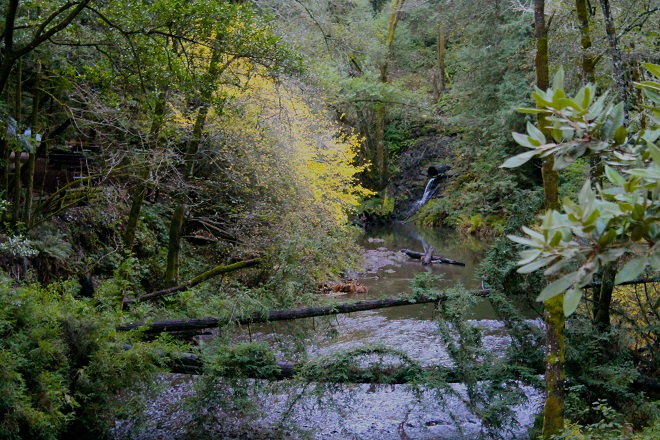
Thanksgiving is a creek’s garbled mumble. It is damp redwood and charcoal. It’s the prickly heat from a fire pit and it’s a raccoon scavenging in a trash bin. When I think of Thanksgiving I see the Salmon Crossing sign on the bridge over the creek and I follow the dirt trail to the giant hollow tree stump that’s big enough to climb into.
My family’s annual tradition is a camping trip in the shady redwoods of Samuel P. Taylor State Park. In the fifth grade, I wrote an essay about the campground entitled, “My Favorite Place” and even then I described it in terms of sensations rather than anecdotal memories. I still have stories to give people a sense of our unconventional celebration of the autumn holiday. There was the year a brave turkey sauntered through our campsite on Thanksgiving morning. And the year our tent succumbed to an unexpected downpour. But they don’t evoke in me the same nostalgia that the slick zip of a tent door or the slimy touch of wet moss do.
The drive to the campground from Fairfax, the town near the park grounds, was a predictable one. There were a few landmarks I used to gauge our distance from the campground, like the sunflower mural under the overpass and the Peace, Love and Grilled Cheese hair salon. After we passed the salon, the road would slope up into the mountains, and I’d know we were near.
I liked to watch the transition from urban to rural, from quaint grocery markets to the forest green whir of coniferous foliage. I speculate sometimes now about where the city and forest converge, where the transition really starts. But I doubt if it’s a question worth pondering. Do changes like that have beginnings?
A series of familiar dips and twists and queasy remarks from my carsick sister would culminate in a euphoric arrival at campsite 19. When we had parked the car, I would gallop out of the sliding minivan door and race to the fence that overlooked the creek below. At the sight of it, exactly as we’d left it the year before, I’d be consumed with an overwhelming happiness so pure that I wonder if I’d still feel it were I to return to the campsite today.
Here, memory fades into a rustic symphony. Raven caws echoed in the treetops, leaves sighed in the chilled breeze, my mom’s voice calling from the car was a whisper. Then smells. Flaming wood and the disappointing char of toasted marshmallow. Comforting morning sounds of pots clinking like heavy wind chimes and blankets rustling like the early birds’ feathers. Mysterious night sounds of the twitching wilderness.
The sensory details have more coherence on the eve of Thanksgiving. My dad would cook most of the day, and were it not for the Weber and his gas stove, you’d never know he’d prepared our feast in the woods. Envious wildlife would salivate while my mom, dad, sister and I shared a traditional bounty with plastic utensils and paper plates under the glow of a kerosene lamp.
The memory shifts again, replaced with the hum of old Christmas tunes from a chunky boom box and the sun’s fingers poking through the holes of the leafy lattice in the sky. In a quick blink I see the canopy’s silhouette on the back on my eyelids, but the sunlight flickers out when I open my eyes again.
The day after the feast, the feeling of finality would approach, gently, and soon it would be time to pack up. Most years, I’d acquiesce to the trip’s end and wave goodbye until next Thanksgiving – I think the necessity of personal hygiene after five days in the forest will put even the sharpest sentimental disappointment into perspective. But my last farewell to Samuel P. Taylor Park two years ago was one of the most difficult to bid and the hardest to understand.
There were a lot of uncertainties that last day. I was a senior in high school and I was unsure when I’d be returning, unsure where I’d be this time next year. I sat on the fallen tree trunk that extends into the creek near our campsite. I visited this spot every year to listen to the creek babble and to think about nothing. It was a spot where hiking passersby could come and go, but the creek would keep talking and I could keep listening. But that last day, the creek talked too loud, like it had something important to say. Every sound of the woods competed for my attention but I couldn’t hear anything over my fear that I’d never come back.
I haven’t returned to Samuel P. Taylor Park since then. I wonder if the fallen tree is still there or if it got fed up with the creek’s incessant gurgling and eroded to drift wood. Two years is hardly a long time, but when I think of things that have changed since then, it’s hard not to worry. The park’s autumn chill that I then called frigid is an oasis compared to winter climate I suffer now. Today a plane ride separates campsite 19 and I, not an hour’s drive.
Though I don’t know when I’ll celebrate another Samuel P. Thanksgiving, it’s good to know that birdcalls can still echo in the trees. Wood will still burn when married with a lit match. And it’s comforting to know that the park’s sounds and scents exist outside of our campsite. Maybe that’s why I don’t like to confine my thoughts about camping to specific memories; it makes them seem too far away, to difficult to recreate. Sensory details stand up much better to time. While the image of a memory may discolor and decay, its smell, its taste and its sound endure even the strongest currents of change.